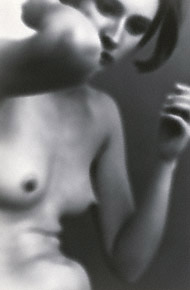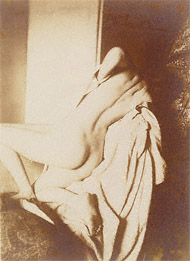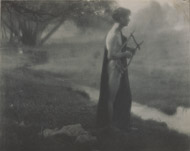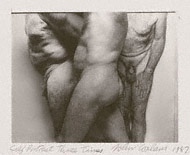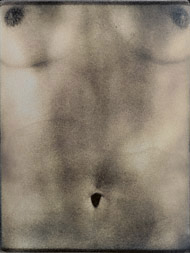|
Like landscape or still life, the nude is one of the great traditional forms in art. An ideal perfected in sculpture by the ancient Greeks, it became the cornerstone of formal artistic training in Europe during the 17th century. The nude became a subject of photography shortly after the invention of the medium was announced simultaneously in Paris and London in 1839. Since then photographers have used a wide variety of materials to render the nude and, in the process, created new imagery.
The Getty Museum holds a substantial number of photographic nude figure studies. The photographs in this exhibition, all from the permanent collection, represent key moments in the history of the genre. Frederick Sommer created a series of intentionally blurred photographs of statues on a trip to Europe in 1960. When he returned to the U.S., he began working with living models. In his image above, the obliterated detail and deep shadows make the body of the living model seem like sculpted stone.
|
 |

 |
 |
Male Figure in Repose, Gaudenzio Marconi, about 1860
|
 |
 |
Gaudenzio Marconi made his living supplying académies (photographic figure studies) to students at the most prestigious art school in Paris, the École des beaux-arts (School of Fine Arts). Accomplished artists and students often sketched the figure from photographs when living models were not available or proved too costly. In this case, Marconi positioned his model in a pose derived from the Barberini Faun, a Roman copy of a Greek original dating from about 220 B.C.
See an image of the Barberini Faun, the inspiration for this photograph (links to Glyptothek, Munich Web site).
|
 |
|
Edgar Degas rejected the conventions of the academic nude and focused on depicting contemporary life. He mastered a variety of artistic mediums (painting, drawing, printmaking, sculpture, and photography), and his obsessive examination of form and technique led him to new ways of handling the figure. This photograph of a woman drying her back in an unusual, contorted pose served as a springboard for the painting After the Bath and several related studies in charcoal and pastel.
See Degas's painting based on this photograph (links to Philadelphia Museum of Art Web site).
|
 |
|
George Henry Seeley took up photography after studying art in Boston and becoming acquainted with F. Holland Day. Seeley became known for making highly idealized figure studies that often suggest imagery created by British poets of the Romantic movement—William Wordsworth, John Keats, and Percy Bysshe Shelley.
The model in this photograph carries a lyre and may represent Orpheus, a mythological Greek musician and a popular subject for 19th-century poets. In his 1821 poem "Hellas," Shelley wrote: "A loftier Argo cleaves the main, / Fraught with a later prize; / Another Orpheus sings again, / And loves, and weeps, and dies; / A new Ulysses leaves once more / Calypso for his native shore."
|
 |
 |
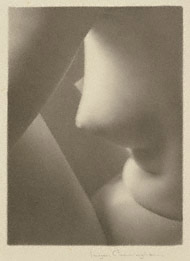
 |
 |
Triangles, Imogen Cunningham, 1928
© The Imogen Cunningham Trust
|
 |
Imogen Cunningham's unique botanical and figure studies made a significant contribution to the aesthetics of Modernism. In the early 1920s she began to eschew the sentimental, soft-focus imagery of her previous work in favor of sharply focused, highly detailed compositions that emphasize form and pattern.
This sensitive rendering of the feminine body is a complex intersection of angles, the result of careful positioning of model, camera, and lighting.
|
 |
|
John Coplans began making studies of his nude body at the age of 53. He created tension in his work by alternately affirming and rejecting the ideals of the classical nude. His hairy, wrinkled torso stands in stark contrast to the smooth, lithe, athletic bodies of ancient Greek statuary, while the narrow stage and sculptural quality of his poses and the monochrome tone of the print suggest a frieze.
This nude self-portrait was made using three separate exposures of Polaroid negative/positive Land film.
|
 |
|
Chuck Close created a series of portraits and figure studies in collaboration with the daguerreotypist Jerry Spagnoli, who has mastered this antiquated process requiring the use of hard-to-obtain, highly toxic materials.
Close, mostly known for his variations on the human face, experimented here with skin as pure form. In choosing a small-busted woman as his model, Close blurred the line between female and male.
|
 |
